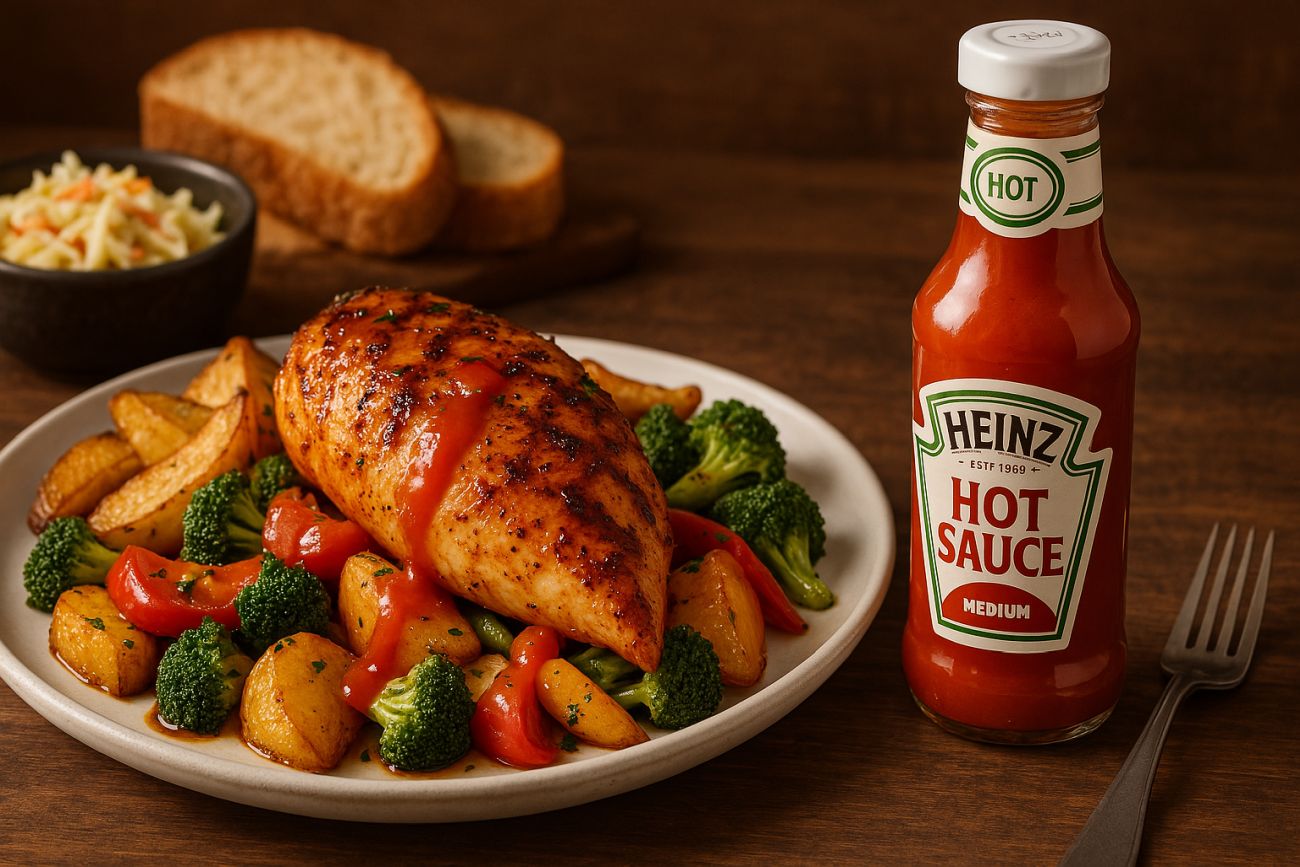Imagine a world without hot sauce. It’s a place where food lacks that fiery kick that makes our taste buds dance. The history of hot sauce is a spicy tale that goes back thousands of years.
It starts with the Aztecs in 7000 BC. They were the first to grow chili peppers and make hot sauce. This sauce was more than just a flavor booster. It was a key part of their culture, shaping the way we eat today.
Hot sauce has come a long way from Central America to becoming a favorite around the world. Its story is one of innovation and cultural exchange. It shows how chili peppers have shaped our food and our culture, still exciting us today.
Key Takeaways
- Hot sauce originated with the Aztecs around 7000 BC
- Chili peppers were used for more than just food—including medicine and religious rituals
- The first commercial hot sauce emerged in 1807
- Hot sauce represents a significant cultural and culinary evolution
- The global hot sauce market continues to grow exponentially
The Origins of Spicy Condiments
Hot sauce has a long history, starting thousands of years ago. Chili peppers were among the first plants grown by humans. The Aztecs and other Mesoamerican cultures were key in making early hot sauces.
In ancient Mesoamerica, peppers were more than food. They were a cultural symbol. The Aztecs made a simple hot sauce by grinding peppers with water and herbs. This spicy mix was used for food, medicine, and even as a status symbol.
The making of hot sauce was a complex process. Aztecs chose and ground specific peppers for their flavors and heat. This showed their advanced understanding of taste and preservation.
As chili peppers traveled, local cultures changed hot sauce recipes. They added their own ingredients and cooking methods. This shows how a simple pepper mix became a global favorite.
Hot Sauce in Ancient Civilizations
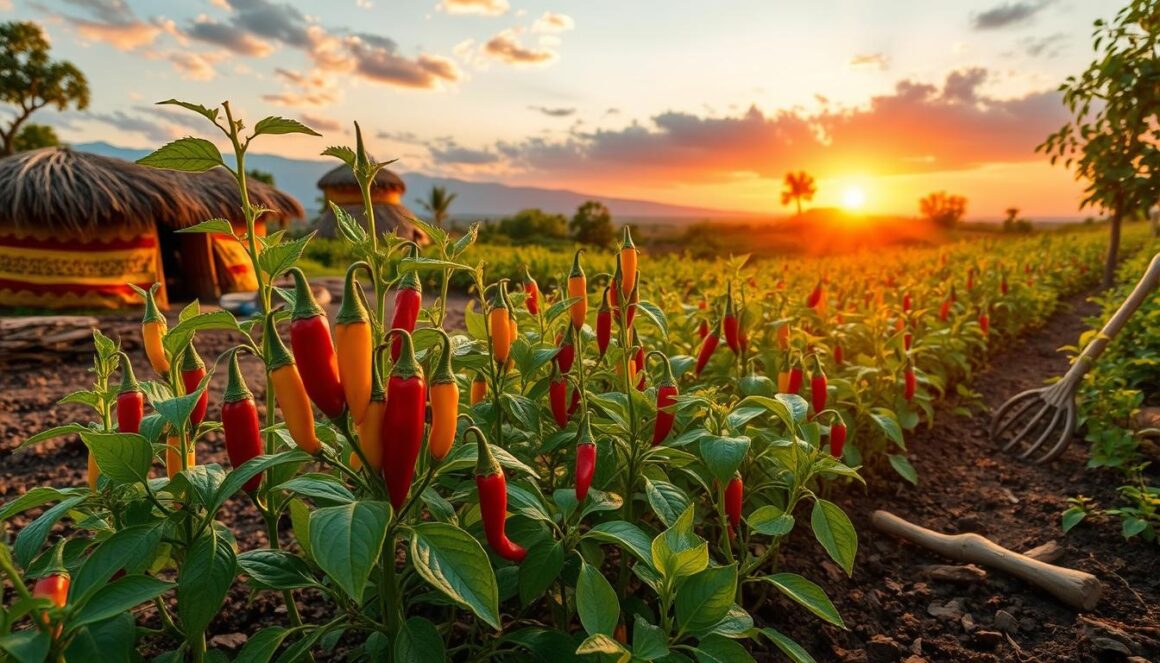
The tale of hot sauce starts in Mesoamerica around 7000 BC. The Aztecs were among the first to make spicy condiments that changed food worldwide. They grew chili peppers in the Tehuacán Valley in Mexico.
Cultural influences were key in hot sauce’s growth. The Aztecs mixed ground chili peppers with water, tomatoes, salt, and herbs to make an early salsa. This hot sauce was not just for taste but also helped preserve food.
As different Mesoamerican cultures tried various chili types, the pepper variety grew. Spanish conquistadors, who arrived in the 16th century, were drawn to these spicy sauces. They took chili peppers and hot sauce-making techniques to the Caribbean, Europe, and Africa.
By 1500 AD, hot sauce was known all over. The addition of vinegar and garlic from European colonizers changed these ancient recipes. This mix of cultures started the hot sauce we enjoy today, showing the creativity of ancient food lovers.
Evolution During Middle Ages
The Middle Ages were a key time for spicy foods. Hungary led the way with paprika, a mild chili pepper seasoning. This changed how people cooked in Europe, adding new flavors and heat.
Asian explorers also made a big impact. They brought ingredients like ginger, garlic, and soy sauce. These added to the variety of spicy condiments, enriching global cuisine.
Trade routes were key for new flavors. Spice merchants carried ingredients far and wide. The Columbian Exchange in 1492 helped chili peppers spread to new lands.
Soon, different hot sauces appeared, each with its own taste. From European paprika to Asian chili oils, the variety was amazing. This showed how diverse spicy foods became in the Middle Ages.
Hot Sauce in the New World
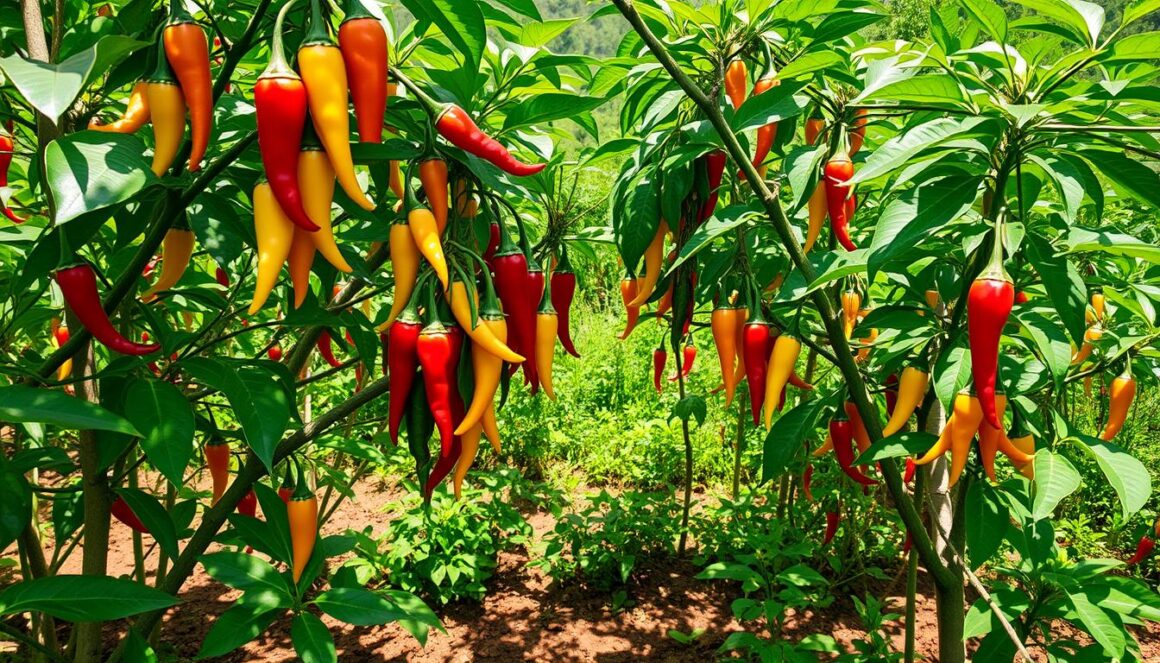
Christopher Columbus changed hot sauce history when he found chili peppers in the Americas. He took them back, thinking they were “peppers.” This name stuck for a long time. The Aztecs, who lived long ago, were the first to make spicy sauces.
Every place made its own hot sauce, showing off its culture. In the Caribbean, scotch bonnet peppers made bright, hot sauces. In Mexico, chiles, onions, and tomatoes mixed to create deep flavors. This mix inspired famous brands like Valentina and Cholula.
In 1848, American soldiers brought Tabasco seeds to the US. Entrepreneurs like Edmund McIlhenny saw its value. They got the first hot pepper sauce patent in 1850. This made hot sauce popular worldwide.
By the late 1800s, hot sauce was more than a condiment. It showed off culture and new cooking ideas. Small makers started trying new recipes. This led to the wide variety of hot sauces we have today.
Industrial Revolution’s Impact on Hot Sauce
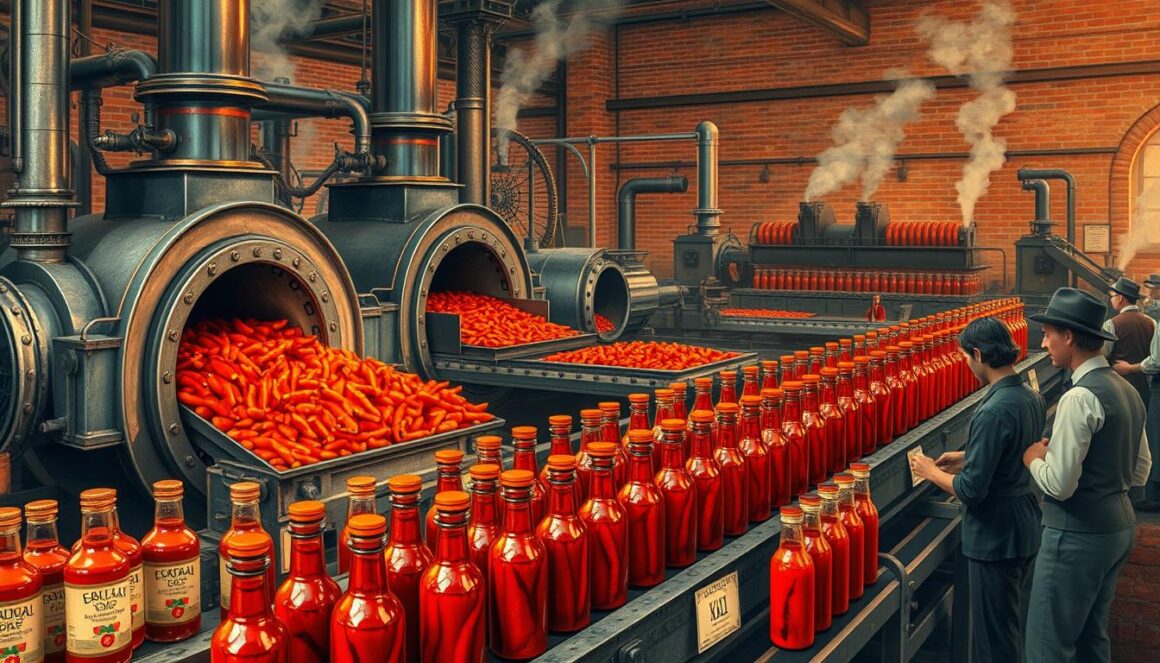
The Industrial Revolution changed hot sauce from a homemade item to a big business. In 1807, Massachusetts saw the first commercial hot sauce. This was a big change for famous hot sauce brands.
Edmund McIlhenny was a key figure in the hot sauce world in the mid-1800s. His Tabasco sauce set new standards for hot sauce making. The discovery of capsaicin helped make sauces more consistent.
By 1900, making hot sauce was a complex industrial process. The market grew fast, thanks to new ways to make and distribute hot sauce. By 2019, the hot sauce market was worth USD 3.77 billion, showing how much it grew.
New technologies let hot sauce makers try different flavors and keep quality the same. Bottling and preservation methods helped hot sauce reach more people. This turned hot sauce into a global favorite.
Modern Day Hot Sauce Varieties
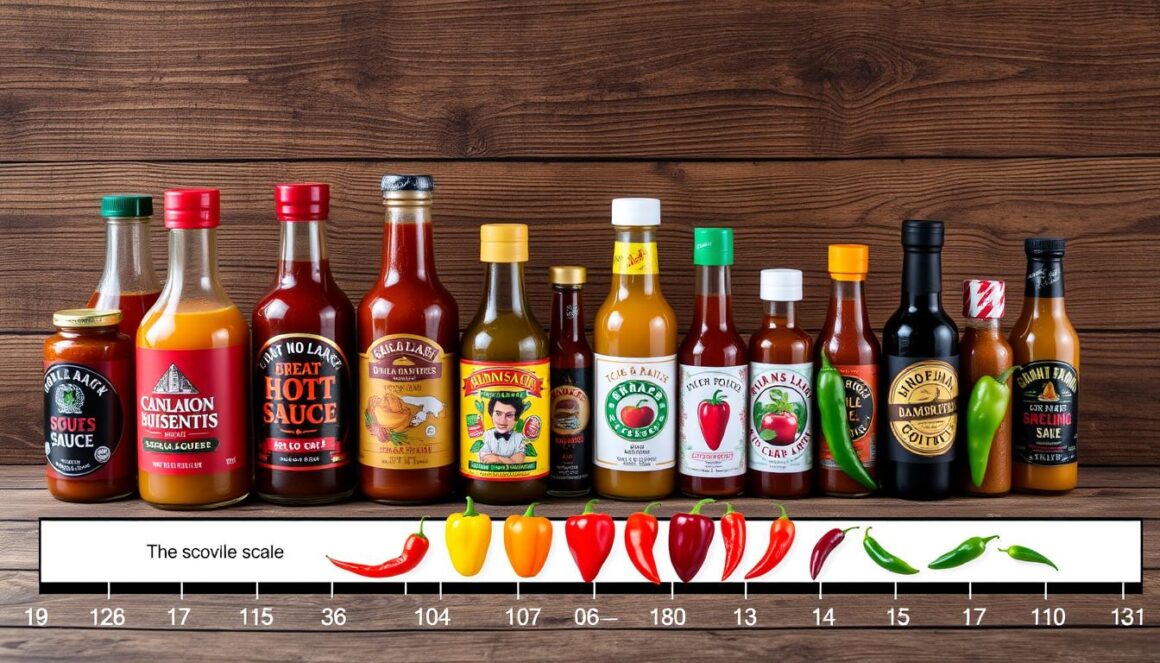
The world of hot sauce has changed a lot since it started. Today, we see many new pepper types and flavors. This is thanks to modern cooking trends and the creativity of hot sauce makers.
The Scoville scale is still key for measuring how hot peppers are. It was made in 1912 by Wilbur Scoville. Now, it helps us understand the wide range of hot sauces available. These sauces can be mild or very spicy, with some reaching over 2 million Scoville units.
Hot sauces from around the world have also made a big impact. We see Asian sriracha, North African harissa, and Caribbean scotch bonnet sauces. These show how different cultures enjoy spicy foods. Craft hot sauce makers also try new things, like adding fruit and herbs, to create unique tastes.
Today, people want more than just heat in their sauces. They look for complex flavors. Small-batch producers have changed the game by offering unique, high-quality sauces. These sauces are loved by those who enjoy trying new and exciting flavors.
Hot Sauce in Contemporary Cuisine
Hot sauce has grown from a simple condiment to a big cultural hit. Today, it’s seen as a key ingredient that breaks old rules. Over 70% of American homes now keep hot sauce handy, thanks to millennials’ love for spicy food.
Brands like Sriracha and Tabasco have become household names. They’ve sparked food challenges and even TV shows. These brands meet the demand for new tastes, offering products that show off different cultures.
Chefs are now using hot sauce in new ways. They add it to everything from fancy breakfasts to fancy cocktails. The hot sauce market was worth $2.3 billion in 2018. It’s expected to hit $3.8 billion by 2026, showing its huge popularity.
Small, artisanal hot sauce makers have also popped up. They offer unique flavors made with special peppers and ingredients. This has turned hot sauce into a true art form in the kitchen.
The rise of food culture and social media has made hot sauce even more popular. It’s now a key part of modern dining, thanks to its trendy appeal.
Conclusion: The History of Hot Sauce
The history of hot sauce is a captivating tale of culinary trends and cultural influences. It spans thousands of years, from ancient Mexico’s chili pepper farms to today’s global market. Now, hot sauce is loved all over the world.
The global hot sauce market was worth USD 2.54 billion in 2020. It’s expected to hit USD 4.8 billion by 2028. This shows how hot sauce has grown in popularity.
Today’s hot sauce making is different from the past. Earlier, people aimed to make the hottest sauces. Now, artisanal brands focus on complex flavors with natural ingredients and new recipes.
This change shows how hot sauce keeps up with what people like and new cooking ideas.
Hot sauce is still a key part of food culture as different cuisines mix. Every year, new hot sauce companies start, and old ones keep coming up with new ideas. This makes the future of hot sauce look very exciting.
Collectors like Vic Clinco and the industry’s love for variety mean hot sauce will keep being a big part of food for years.
FAQ
When and where did hot sauce originate?
Hot sauce started in ancient Mesoamerica, with the Aztecs. They mixed chili peppers with water and herbs. They used it for food, medicine, rituals, and even as money.
How did chili peppers spread around the world?
Chili peppers traveled through trade and exploration. Christopher Columbus’s voyages helped spread them. They reached Europe, Asia, and Africa, where locals made their own hot sauces.
What is the Scoville scale?
The Scoville scale measures chili pepper heat. It ranges from 0 (bell peppers) to over 2 million (Carolina Reaper). It helps people know how spicy a hot sauce is.
When was the first commercial hot sauce produced?
The first commercial hot sauce was made in 1807. Tabasco sauce, created in 1868, was a big step. It helped start the hot sauce industry.
What makes chili peppers hot?
Capsaicin makes chili peppers hot. It tricks the mouth into feeling pain, like burning. The heat level depends on the pepper and capsaicin amount.
How have hot sauce recipes evolved?
Hot sauce recipes have changed a lot. From the Aztecs’ simple mix to today’s sauces with ginger, garlic, and vinegar. Now, there’s a wide variety of hot sauces.
What are some popular global hot sauce styles?
There are many hot sauce styles worldwide. Sriracha from Thailand, harissa from North Africa, and scotch bonnet sauces from the Caribbean. Each has its own flavor, based on local ingredients and traditions.
Are hot sauces only used for adding heat?
No, hot sauces do more than just add heat. They add flavor, are used in marinades, and even in cocktails. They’re also used for health benefits in some cultures.
How spicy can hot sauces get?
Hot sauces can be very mild or very hot. Some use peppers like the Carolina Reaper, which is over 1.5 million Scoville Heat Units. These are for the brave spice lovers.
What current trends are emerging in hot sauce?
Today, hot sauce trends include small-batch, health-focused, and sustainable options. There’s also a rise in exotic flavors and plant-based sauces. The market keeps evolving to meet different tastes.

